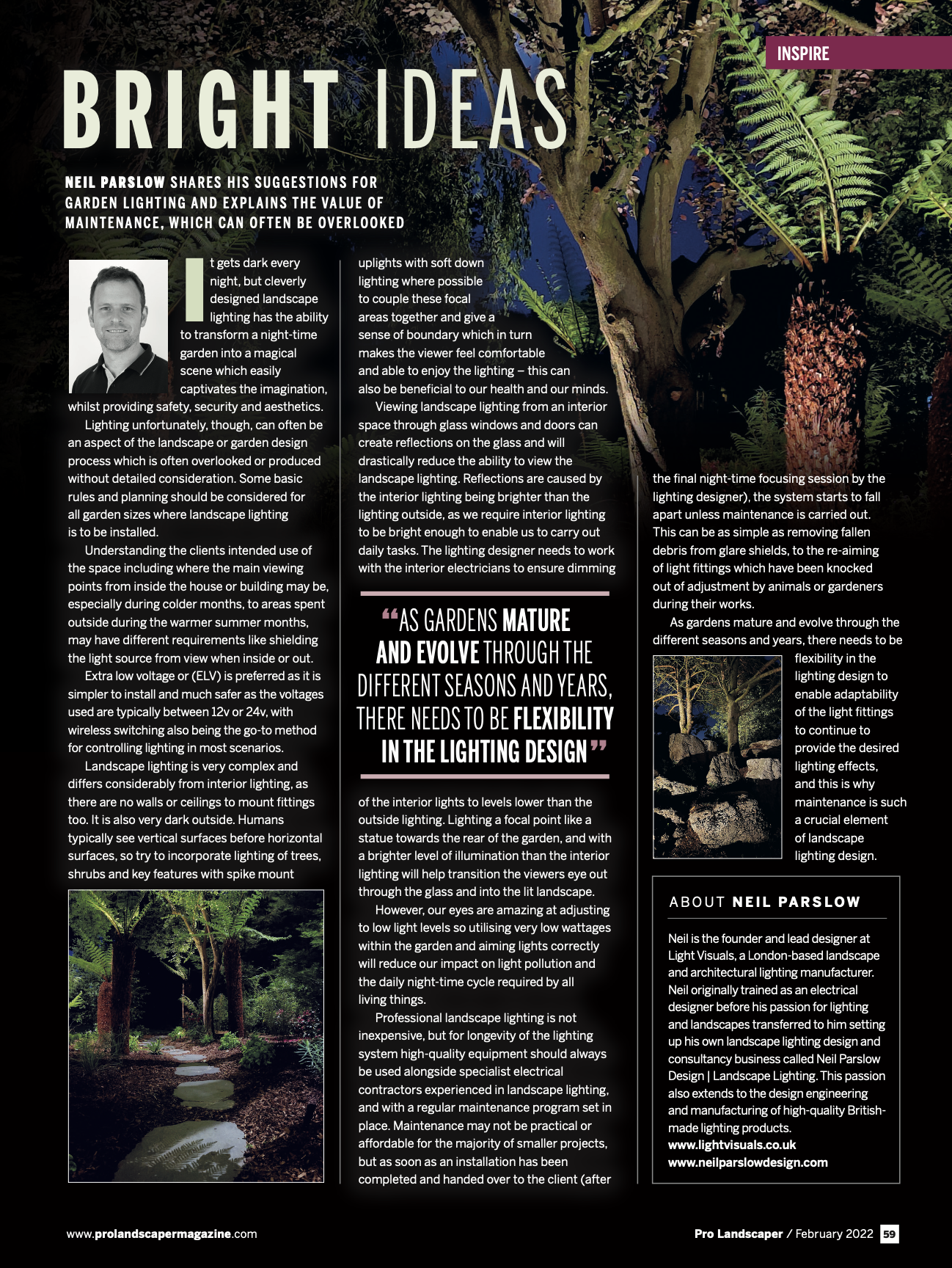Pro Landscaper Magazine February 2022 Bright Ideas
Pro Landscaper Magazine February 2022 Bright Ideas
NEIL PARSLOW SHARES HIS SUGGESTIONS FOR GARDEN LIGHTING AND EXPLAINS THE VALUE OF MAINTENANCE, WHICH CAN OFTEN BE OVERLOOKED
It gets dark every night, but cleverly designed landscape lighting has the ability to transform a night-time garden into a magical scene that easily captivates the imagination, whilst providing safety, security and aesthetics.
Lighting unfortunately though, can often be an aspect of the landscape or garden design process which is often overlooked or produced without detailed consideration. Some basic rules and planning should be considered for all garden sizes where landscape lighting is to be installed.
Understanding the client’s intended use of the space including where the main viewing points from inside the house or building may be, especially during colder months, to areas spent outside during the warmer summer months, may have different requirements like shielding the light source from view when inside or out.
Extra-low voltage or (ELV) is preferred as it is simpler to install and much safer as the voltages used are typically between 12v or 24v, with wireless switching also being the go-to method for controlling lighting in most scenarios.
Landscape lighting is very complex and differs considerably from interior lighting, as there are no walls or ceilings to mount fittings too. It is also very dark outside. Humans typically see vertical surfaces before horizontal surfaces, so try to incorporate lighting of trees, shrubs and key features with spike mount uplights with soft down lighting where possible to couple these focal
areas together and give a sense of boundary which in turn makes the viewer feel comfortable
and able to enjoy the lighting – this can also be beneficial to our health and our minds.
Viewing landscape lighting from an interior space through glass windows and doors can create reflections on the glass and will drastically reduce the ability to view the landscape lighting. Reflections are caused by the interior lighting being brighter than the lighting outside, as we require interior lighting to be bright enough to enable us to carry out daily tasks. The lighting designer needs to work with the interior electricians to ensure dimming
AS GARDENS MATURE AND EVOLVE THROUGH THE DIFFERENT SEASONS AND YEARS, THERE NEEDS TO BE FLEXIBILITY IN THE LIGHTING DESIGN
of the interior lights to levels lower than the outside lighting. Lighting a focal point like a statue towards the rear of the garden, and with a brighter level of illumination than the interior lighting will help transition the viewer’s eye out through the glass and into the lit landscape.
However, our eyes are amazing at adjusting to low light levels so utilising very low wattages within the garden and aiming lights correctly will reduce our impact on light pollution and the daily night-time cycle required by all living things.
Professional landscape lighting is not inexpensive, but for longevity of the lighting system high-quality equipment should always be used alongside specialist electrical contractors experienced in landscape lighting, and with a regular maintenance program set in place. Maintenance may not be practical or affordable for the majority of smaller projects, but as soon as an installation has been completed and handed over to the client (after the final night-time focusing session by the lighting designer), the system starts to fall apart unless maintenance is carried out. This can be as simple as removing fallen debris from glare shields, to the re-aiming of light fittings which have been knocked out of adjustment by animals or gardeners during their works.
As gardens mature and evolve through the different seasons and years, there needs to be flexibility in the lighting design to enable adaptability of the light fittings to continue to provide the desired lighting effects, and this is why maintenance is such a crucial element of landscape lighting design.

